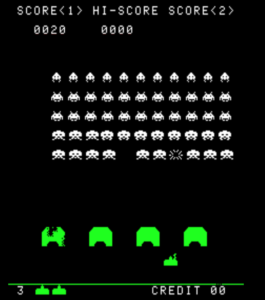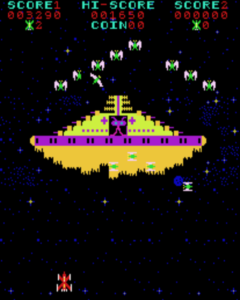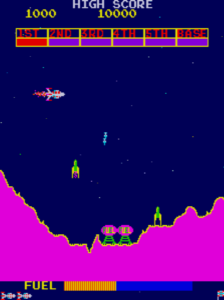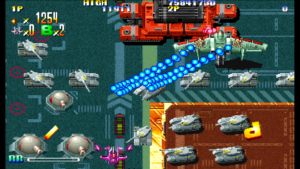Evolution of the Japanese Shooter
The shooting game is a long-time staple of Japanese arcades, and one of the most recognizable game genres there is. From humble beginnings in the days of Space Invaders, it evolved into an increasingly complex form, ending in the bullet hell shooters we see today.
There have been many, many fantastic titles over the years, but while most are content to tread the same path as their peers, a few key titles went further, and pushed the genre forward. We’re looking at those games now, as we trace the evolution of the Japanese shooter.
Zapping aliens was once the quintessential gaming experience. Nowadays, there’s far more variety in our gaming diets and though that’s perhaps a change for the better, there’s still nothing like a good old fashioned shooter to test the nerves and reflexes. Let’s go through the games one by one, and see how the genre developed.
Space Invaders – 1978
Space Invaders is arguably the most iconic game of all time. The one that even your Gran knew about back in the days when older ladies didn’t typically know about such things. The aliens moving from side to side, the increasingly fast der, dun, der, dun sound, the ship dodging behind the bases. Space Invaders is a game of simple ingredients, but it’s amazing how well it all hangs together. Everything in the game just works, and it is still worth a play today.
Space Invaders burst into existence in 1978 and sequels are still being made, with recent updates for smartphones and home consoles building on the old formula. Space Invaders Infinity Gene, Space Invaders Extreme and other spin offs bought the series to new generations of gamers.
Developed at Taito and designed by Tomohiro Nishikado, Space Invaders made great use of the limited technical tools at its disposal. The game’s colors are created by strips on the display unit glass, and speed changes as the enemies are killed is simply a result of the processor slowing down when all the enemies are still alive.
Space Invaders, needless to say, was a smash hit, gaining popularity first in Japan, and then throughout the world. Total sales of $13 billion are a testament to the game’s enduring appeal and as well as making money, it inspired legendary developers, including Shigeru Miyamoto and John Carmack.
Phoenix – 1980
Space Invaders was a simple game, but things would soon get much more complex. Several similar games would follow in its wake, such as Galaga and Galaxian. These introduced new ideas, such as aliens swooping down in formation, and the ability to capture incoming enemies and turn them against their friends.
Phoenix arrived in 1980 and took the shooter formula further, with different levels and featuring a variety of enemies. You’ve also got a shield to protect you from the onslaught.
The grand finale is one of gaming’s first boss battles. After downing a few screens of minions, you had to take on the boss alien himself, hiding at the center of a massive flying saucer.
Your bullets gradually carve a path through the ship’s armour, which included a rotating belt that also has to be worn down. Once it is damaged enough, you can send a shot all the way through to take out the alien leader. It’s a great gaming moment and a lot more satisfying than the health bars many later games would use for bosses.
The origins of the game are unclear, with US developer Centuri licensing it from a company based in Phoenix, Arizona, but also claiming in interview to have licensed it from a ‘smaller Japanese developer.’ Taito eventually released it in Japan.
Whether Japanese or American, Phoenix was a great game that added a sense of progression to the endless screens of aliens most other games presented you with. The shield also hinted at the increase in complexity that was to follow.
Scramble – 1981
In February of 1981, Konami’s Scramble added scrolling to the mix, along with multiple distinct phases in each level. It also gave you multiple weapons, with both a forward firing gun and bombs to manage. Your fuel gauge, ticking down as you flew forward, had to be topped up as you went. This trope didn’t really catch on, but the multiple weapons would become a staple of the genre, as would the scrolling levels.
Scramble was also a fairly plausible looking game. You were invading what looked like a moonbase protected by defensive missiles and occasional swarms of aliens. As the genre progressed, enemies would get more spectacular and more abstract, but Scramble’s grounded approach and scrolling levels gave it a more solid feel to many of its predecessors.
Scramble gave you more to think about than simply firing your gun at the baddies. Positioning and strategy were important. The fuel management meant you had to plan a little bit too. Soon though, things would get more complex still.
Gradius – 1985
We’re jumping four years to 1985 now, but staying with Konami. Gradius, released in the West as Nemesis, is sometimes viewed as an indirect sequel to Scramble, but it’s far more of an archetypal scrolling shooter than its earlier sibling. Gradius allows you to collect power-ups, which can be traded in for different upgrades. These include extra speed and a variety of weapons.
The upgrades transformed your ship so much that playing the game is a completely different prospect when you are fully tooled up to when you start with your weedy pee shooter. This gave the genre another of its gameplay staples – losing a life would make it extraordinarily difficult to make progress, particular as later games made a virtue of their spiraling difficulty. That brings us on to one of the all-time greats.
R-Type – 1987
R-Type perhaps represents a peak for the shooter genre. It’s brilliance of design was matched by its off-puttingly fearsome difficulty – few players would reach the end, but many would try, pumping in coins, desperate to get a little further and see more of its amazing sights. Massive alien ships took up entire levels, huge Geigeresque monsters snaked across the screen, and levels made of flesh intertwined with technology took visuals to new heights.
Later games might have been better, but R-Type came at a time when shooters still seemed to matter. Four years later in 1991 Street Fighter 2 hit the arcades and the new multiplayer beat-em-ups would dominate the arcade scene over the coming years.
Gamers’ genre of choice had shifted. After that scrolling shooters became more and more niche. That’s not to say they got worse, some stunning games would follow, and still do, but few of the later games in this list resonate in the popular consciousness as much as R-Type. But shooters weren’t finished yet.
Giga Wing – 1999
Giga Wing isn’t the most well known game on this list, but it’s an early example of a bullet hell shooter and a good representative of what the game style is all about. In this kind of game enemy bullets pour toward you from all directions, and survival is a matter of hunting for the tiny spot on screen where you can remain safe.
These games are a visual feast, despite only being in 2D, and interpreting the waves of enemy fire and finding a path through the chaos is what they’re all about. There are loads of games like this, but Giga Wing is a personal favourite, having fought through its levels on a handful of 50 yen coins many years ago.
Since staying alive for more than 30 seconds is quite challenging in these games, they weren’t hugely popular. The shooter had become a genre for genre specialists. The Playstation had widened gaming’s audience and accessibility was becoming more and more important to publishers.
There were still new ideas waiting to be discovered however.
Rez – 2001
This is a bit of an offshoot, as it isn’t a traditional shooter by any means. It’s not even an arcade game, but a console title that has recently been re-released in VR. It does though, seem part of the same lineage, with its abstract shapes and waves of enemies.
Weird, cool, but far more accessible than nearly all modern shooters, a competent player can reach the end of it in no time at all. They’ll probably want to play it again though.
Rez is both a game and an experiment. You float through surreal 3D landscapes, shooting at enemies with a weapon that plays beats as it fires. Lock onto multiple enemies and the rhythmic musical response goes on for longer. The further you get through the levels, the more intense the music gets.
Back in 2001 the game was a marvel, sparking those never ending discussions on whether games could be art. Inspired by Kandinsky, it aims to create a state of synesthesia, blending your senses and making the visuals and sounds flow into one another. At times Rez is a game. At others it is sound. But really it’s both. The experiment works.
Though released years ago, it’s design was so strong it survived the update to VR, and is a perfect fit for the new technology. It’s continuing appeal shows how forward thinking Tetsuya Mizuguchi’s original Playstation 2 creation was.
Like Space Invaders, the visuals go hand in hand with the sound to create the experience. We’ve come a long way, but not everything has changed.
Ikaruga – 2001
Back to more traditional territory now. Ikaruga gives you a ship that can switch colour from black to white. The enemies are all one colour or the other, and cleverly, you’re only vulnerable to bullets of the opposite hue.
Chaining kills in groups of the same colour lets you rack up seriously big points, but doing so is not for the faint hearted. Survival is a more attainable goal for new players.
It was a tough call which of Treasure’s classics took this spot, but we plumped for Ikaruga over Radiant Silvergun. Radiant Silvergun is very much worth playing though, and feels a bit less austere than Ikaruga.
Both games have a feature where they roll out credits the more you play, which seemed a little unsatisfying to us at first. It meant you were relying on self-discipline if you wanted to finish the game on a respectable amount of credits.
But these games weren’t about getting to the end anymore, they were about winning with as much style as possible, climbing up the high score table by ever greater mastery.
The Here and Now:
Though recently updated, Rez came out nearly twenty years ago, as did Ikaruga. In those years bullet hell shooters have flourished, though mostly outside the eye of the mainstream. Cuphead made waves recently, and is a fine game, if not a genre changing one.
For those looking to pick up older games, collections of retro classics regularly appear in online stores. The recent Gradius collection on Switch is worth a look for example, as is the Darius collection.
Switch online subscribers should also check out their NES and SNES libraries for Star Solder, Twinbee, and others. Mini-consoles are great places to look, too. R-Type has a good remaster available on Steam, and other platforms.
There are other modern Japanese shooting games of course, Splatoon for example, but that feels cut from a different cloth to those we’ve listed here. We know we haven’t mentioned everything, Raiden, Metal Slug and various gun gallery games, for example. Why not check those out yourself? They’re worth a look.
The traditional shooter itself has developed from an arcade staple into a bit of a niche pursuit. It isn’t the most visible genre around these days and that’s a shame, given its rich history. On the plus side, there is plenty of that history to explore and more and more of it is available to download and play. Why not have a look through the games here, and see what you can find? They’re better to play than to read about. Have fun!
You can follow any responses to this entry through the RSS 2.0 feed. You can leave a response, or trackback from your own site.






Leave a Reply